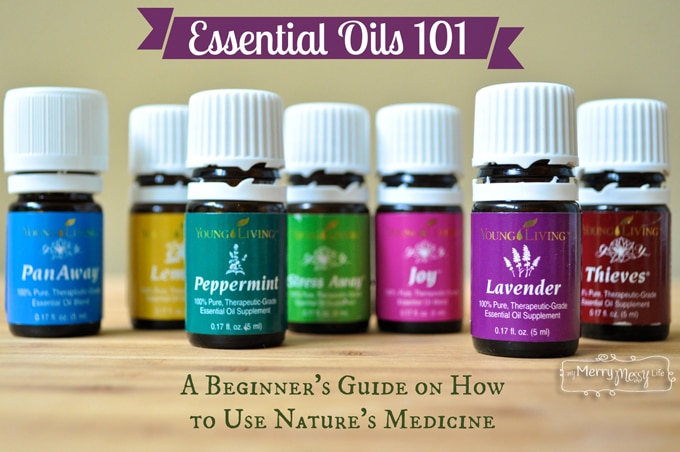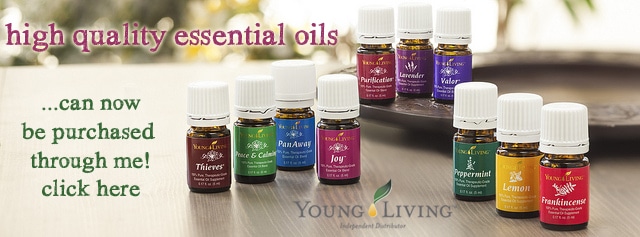Essential oils are so powerful and work with the body to help it heal itself. Here's a complete beginner's guide on how to begin using these amazing oils safely and effectively!

What Exactly Are Essential Oils?
Ever peeled an orange or squeezed a lemon and immediately noticed the strong fragrance? Or smelled a rose and was taken to another state of mind, even for a minute? You were experiencing the essential oil of the plant!
EO’s are natural aromatic compounds found in the raw material of plants (leaves, stems, bark, petals, etc). The oils of plants contain the essence (this is where the word “essential” comes from) or scent of that particular plant. Therapeutic grade oils are extracted from the plant using steam distillation and are super concentrated, which is why they should be used with respect and caution.
They Are Nature's Medicine
I think the coolest fact about EO’s is that they are the regenerating, oxygenating, and immune defense properties of plants. In other words, they protect the plant from bacteria, fungi and critters who want to eat it, which is why they are so effective in helping to protect and heal us as well (source)! According to this fantastic book, “Quick Reference Guide for Using Essential Oils,” (where to buy) they are:
“lipid-soluble and are capable of penetrating cell walls, even if the cell wall has hardened because of an oxygen deficiency. In fact, essential oils can affect every cell of the body within 20 minutes and then be metabolized like other nutrients.”
Wow! They are effective, powerful little suckers that can actual heal the cell walls – is this our cure to cancer? Perhaps.
Some Fun Essential Oil Facts
EO’s were commonly used long ago for their medicinal and therapeutic properties and have gained popularity today for people like me who like alternative medicine and prefer homemade non-toxic products. Many EO’s are antiseptic and antibacterial, mood enhancers and even aphrodisiacs!
- When inhaling, it takes 22 seconds for an oil to reach the brain.
- When applied topically, it takes 2-3 minutes for an oil to reach the bloodstream, 20 minutes to affect every cell in the body, and 2 1/2 hours to fully metabolize.
- It takes about 16 pounds of peppermint leaves to make one ounce of oil.
- It takes 3 tons of plant material to make 1 pound of Melissa oil.
What Can We Use them For?
Essential Oils are very versatile – I have used them to clean and disinfect my house, to treat illnesses, to deodorize, to disinfect the air, to create a mood, to treat sore muscles, headaches, fevers, colds and more. I use Young Living Essential Oils (where to buy) and they can be used:
Internally
Many of the single oils may be used as dietary supplements by dropping into empty capsules to swallow, or dripping in the throat or under the tongue (see this chart to know which ones from Young Living can be use internally).
Aromatically – Diffusing and Sniffing
Diffusing and smelling oils is the easiest and safest way to use them. It's called Aromatherapy for a reason! It is also my favorite as I love to set a mood in the house with my favorite blends (like Stress Away, Valor, Joy, etc). I have also found oils are very effective to diffuse at night when my children have colds or a bad cough – it really lessens the severity and duration of their cold. I have also diffused when I'm feeling sluggish, tired, anxious, or just not up to par – it really helps to clear my head while I enjoy the wonderful, non-toxic fragrance!
You can even just sniff or inhale an oil straight from the bottle to get therapeutic benefits. For instance, my oldest son really suffers from car sickness, so I give him a cloth with peppermint oil on it to sniff while we drive and it helps him a lot!
Topically
Essential Oil Safety
Like I mentioned above, it takes 16 pounds of peppermint leaves to make one ounce of oil and about 85 lemons to make one ounce of lemon oil. In other words, essential oils are very concentrated, very powerful oils. A little goes a very long way, especially when it comes to applying them topically.
To Dilute or Not Dilute?
I love using essential oils on the skin to fight viruses like colds and the flu, treat insect bites, acne and eczema. However, I believe this should be done with caution. There is quite a bit of debate when it comes to applying the oils diluted or neat – most aromatherapists say that lavender is the one oil that can be applied neat, yet others say none at all. Young Living does say there are quite a few of their oils that can be applied neat, but honestly, I would use caution.
When and How to Dilute
One thing most agree on is to dilute for small children and the elderly, so I would start there at the very least.
- Infants to Two Years: 1-3 drops essential oil to 1 tablespoon carrier oil
- Children ages 2-5: 1-3 drops essential oil to 1 teaspoon carrier oil
As for the rest, a general rule of thumb is if the oil needs to be diluted, dilute by 2% if you're not applying to a large area of the body. If applying to a large area of the body, then the carrier oil should amount to 15-20%. How to figure out exactly how many drops that is? Read below.
Conversions
There are around 20 drops of essential oil in 1 ml, which is:
- 1/8 oz. = 75 drops
- 1/4 oz. = 150 drops
- 1/2 oz. = 300 drops
- 1 oz. = 600 drops
I generally like to use teaspoons and tablespoons (and not ounces) to measure for my family, so:
- 1% dilution = 6 drops essential oil to 2 tablespoons carrier oil (1 ounce) (like Young Living's V-6)
- 2% dilution = 12 drops essential oil to 2 tablespoons carrier oil (1 ounce)
- 15-20% dilution (for massage oil) = 40 drops to 2 tablespoons carrier oil (1 ounce)
Young Living gives a handy-dandy little booklet with the Everyday Essential oils order (see here) that has a chart with which oils should be diluted and which ones are safe to use neat. I'm in the process of recreating it for you and adding some other helpful info so you can have your own pocket guide.
Skin Sensitivities Can Develop
My children have gotten rashes even when I dilute lavender, so I always dilute. A sensitivity can be permanent and can be anything from a mild rash to anaphylactic shock. This isn't to scare you – just be cautious and treat essential oils like prescription medication. My son accidentally got some peppermint oil near his eye one time while he was smelling it, and now if gets any essential oils on his face, even a highly diluted one, his eyes start watering and he gets scared.
Oil Dissolves Oil
If the oils do burn or get into an area like the eyes, water will not help to get it out, in fact, it'll make it worse! Use a carrier oil like Young Living's V-6 oil, organic olive oil (where to buy), sweet almond oil (where to buy), grape seed oil (where to buy), etc. and rub it on the area to dilute the oil. Remember – oil dissolves oil but water doesn't.
See all my recipes using essential oils here!

